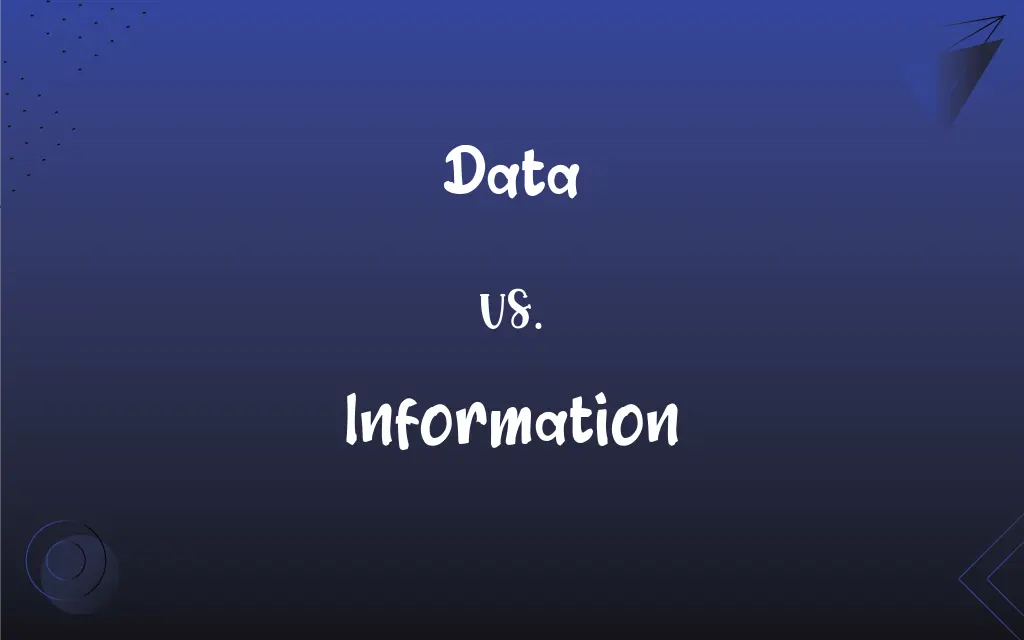Data vs. Information: What's the Difference?
Edited by Aimie Carlson || By Harlon Moss || Updated on October 2, 2023
Data are raw, unprocessed facts and figures without context, while information is data that has been processed or organized such that it has meaning.

Key Differences
Data, by nature, encompasses raw facts and figures without inherent meaning or context, such as numbers, dates, and strings of text, which stand in contrast to information, where the data has been processed or organized in a manner that provides it with context, rendering it meaningful and useful.
In scientific research or computing, data often involves quantitative, qualitative, or mixed-method inputs that lack intrinsic interpretative value, whereas information emerges when that data is analyzed and contextualized, thus becoming valuable and purposeful in decision-making processes.
From a technological viewpoint, data in databases, spreadsheets, or other digital formats requires analysis and interpretation to transition into information, implying that data acts as the raw material from which information, offering discernible meaning, is generated.
Within communication contexts, transmitting data does not inherently convey meaning to the recipient until it has been transformed into information, ensuring that meaningful messages are derived from the primary data and effectively communicated.
In various professional fields, such as business or healthcare, data collection is crucial, yet it is the conversion of this data into information, via analysis and interpretation, that facilitates informed decision-making, strategic planning, and consequent action.
ADVERTISEMENT
Comparison Chart
Definition
Raw facts and figures without context
Processed data that has meaning
Utility
Requires processing to be useful
Is useful and can influence decision-making
In Communication
Does not convey meaning
Conveys meaning and can be communicated
In Decision-making
Not directly applicable
Essential and applicable
Data and Information Definitions
Data
Subject to validation and verification.
The researcher verified the data for accuracy.
ADVERTISEMENT
Information
Offers context and facilitates understanding.
The information clarified the complex scenario.
Data
Non-contextual and non-informative in its raw form.
Without analysis, the data could not inform the study.
Information
Processed and organized data that provides meaning.
The information was crucial in developing the strategy.
Data
Raw material for analysis.
The scientist recorded all the data without interpreting it.
Information
Can be used for decision-making processes.
The manager utilized the information to make a decision.
Data
Quantitative or qualitative variables.
The data included both numerical and categorical variables.
Information
Informs, instructs, or enlightens the recipient.
The information provided insight into the ongoing issue.
Data
Unprocessed facts and figures.
The data from the experiment was collected meticulously.
Information
Is communicative and conveys meaning.
The document contained vital information for the project.
Data
Plural of datum
Information
Knowledge or facts learned, especially about a certain subject or event.
Data
Information, especially in a scientific or computational context, or with the implication that it is organized.
The raw information was processed and placed into a database so the data could be accessed more quickly.
Information
The act of informing or the condition of being informed; communication of knowledge
Safety instructions are provided for the information of our passengers.
Data
(collectively) Recorded observations that are usually presented in a structured format.
Information
(Computers) Processed, stored, or transmitted data.
Data
(computing) A representation of facts or ideas in a formalized manner capable of being communicated or manipulated by some process.
Information
A numerical measure of the uncertainty of an experimental outcome.
Data
Senseid|en|telephony}}(mobile telephony) {{ellipsis of mobile data: digital information transmitted using the cellular telephone network rather than Wi-Fi.
Run out of data
Information
(Law) A formal accusation of a crime made by a public officer rather than by grand jury indictment in instances in which the offense, if a federal crime, is not a felony or in which the offense, if a state crime, is allowed prosecution in that manner rather than by indictment.
Data
See Datum.
Data
A collection of facts, observations, or other information related to a particular question or problem; as, the historical data show that the budget deficit is only a small factor in determining interest rates.
Data
Information, most commonly in the form of a series of binary digits, stored on a physical storage medium for manipulation by a computer program. It is contrasted with the program which is a series of instructions used by the central processing unit of a computer to manipulate the data. In some conputers data and execuatble programs are stored in separate locations.
Data
A collection of facts from which conclusions may be drawn;
Statistical data
FAQs
How is information defined?
Information is data that has been processed or organized in such a way that it has meaning. For instance, it may involve interpreting the raw data to understand trends or patterns.
Can data and information be used interchangeably?
No, data is unprocessed facts and figures, while information is data that has been processed and conveys meaning.
How does data become information?
Data becomes information when it is processed, analyzed, interpreted, and organized in a way that provides context, relevance, and purpose.
What is the basic definition of data?
Data refers to raw facts and figures without context, such as numbers, dates, and strings of text that alone have no meaning.
Why is data important?
Data is crucial because it serves as the foundational building blocks to create information, which can then be used for knowledge, wisdom, and decision-making.
Can you provide a synonym for information?
A synonym for information might be "intelligence" or "insights", though both carry nuanced differences.
How is data collected?
Data can be collected through various methods, including surveys, observations, experiments, and from existing sources like databases.
What role does data play in research?
In research, data serves as the empirical evidence or foundational input upon which analysis and conclusions are based.
Why is information vital in communication?
Information is vital in communication because it conveys the intended message or knowledge from the sender to the receiver, facilitating understanding and action.
How can information be visualized?
Information can be visualized using charts, graphs, maps, dashboards, or any graphical representation that communicates insights effectively and clearly.
How is information created?
Information is created by processing and analyzing data, adding context, and deriving meaning or insights from it.
How do modern technologies impact data and information management?
Modern technologies, like big data analytics and artificial intelligence, have transformed how data is processed, analyzed, and turned into meaningful information, enabling more robust and real-time decision-making.
What is an example of data in a business context?
An example of data in a business context could be raw sales figures, such as the number of units sold each day.
Can data be qualitative?
Yes, data can be qualitative, such as colors, textures, or any non-numerical data that can be used to describe characteristics.
What is a common synonym for data?
A common synonym for data might be "facts" or "figures", though neither captures the exactness of its meaning.
What is the relationship between data and information in the knowledge hierarchy?
In the knowledge hierarchy, data is at the base level, providing the raw material that, when processed, becomes information, which can further be used to generate knowledge and eventually, wisdom.
How is data stored?
Data is stored in various formats and locations, such as databases, data warehouses, or cloud storage, depending on the need and technology available.
How is information disseminated or communicated?
Information can be disseminated through various channels, like reports, presentations, meetings, emails, or digital platforms, depending on the audience and purpose.
How does a business utilize information?
Businesses utilize information to make informed decisions, such as determining market trends and establishing strategies based on processed and interpreted data.
What is the significance of information?
Information is significant because it allows for informed decision-making, helping individuals and organizations to navigate through various situations knowledgeably.
About Author
Written by
Harlon MossHarlon is a seasoned quality moderator and accomplished content writer for Difference Wiki. An alumnus of the prestigious University of California, he earned his degree in Computer Science. Leveraging his academic background, Harlon brings a meticulous and informed perspective to his work, ensuring content accuracy and excellence.
Edited by
Aimie CarlsonAimie Carlson, holding a master's degree in English literature, is a fervent English language enthusiast. She lends her writing talents to Difference Wiki, a prominent website that specializes in comparisons, offering readers insightful analyses that both captivate and inform.































































